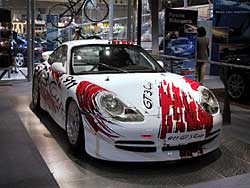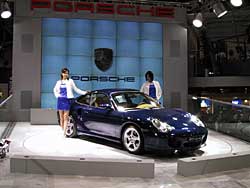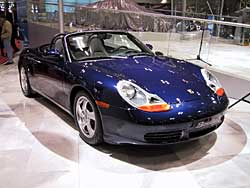
Car Highlights
Reference Vehicle
911 GT3 Cup Car
 The 911 GT3 Cup is currently one of Europe's most popular one-make car races. Porsche's 911 GT3 Cup Car is a competitively finessed race car version of the standard 911 GT3. Maximum output is 370 ps (272 kW), up from the 360 ps (265 kW) of the standard 911 GT3. In the area of motor sports, Porsche has a proud record and tradition based on providing competitive cars to private teams. The Porsche record of success, built on race track performance, is faithfully fed back to Porsche street cars. The 911 GT3 stereet version completed the northern circuit of the Nurburgring track in seven minutes 58 seconds to set a course record for a standard production car. The 911 GT3R won in its class at this year's Le Mans and achieved a debut win in Japan that is still fresh in the minds of many.
The 911 GT3 Cup is currently one of Europe's most popular one-make car races. Porsche's 911 GT3 Cup Car is a competitively finessed race car version of the standard 911 GT3. Maximum output is 370 ps (272 kW), up from the 360 ps (265 kW) of the standard 911 GT3. In the area of motor sports, Porsche has a proud record and tradition based on providing competitive cars to private teams. The Porsche record of success, built on race track performance, is faithfully fed back to Porsche street cars. The 911 GT3 stereet version completed the northern circuit of the Nurburgring track in seven minutes 58 seconds to set a course record for a standard production car. The 911 GT3R won in its class at this year's Le Mans and achieved a debut win in Japan that is still fresh in the minds of many.
Display Cars
New 911 Turbo
 Turbo-charged Porsches won various victories as race cars in the early seventies. Based on their absolute dependability, in 1974 the 911 Turbo debuted as a production car (code named "930") and astounded motor sports fans all over the world with its speed. In particular, owners marvelled at its body-pinning acceleration. The new 911 Turbo offers a top speed of 305 km/h and accelerates to 100 km/h in just 4.2 seconds. Its 3.6-liter engine has the specs that will become tomorrow's standards. The twin turbo-charged six-cylinder engine fitted with an intercooler outputs a maximum of 420 ps (309 kW) at 6,000 rpm and produces maximum torque of 560 Nm at 2,700 rpm. But the special features of the new 911 Turbo go beyond the performance of its engine and its drivability. The generous range of standard features and a revised body design are also major attractions. The front and rear end designs set the new 911 Turbo apart from the rest of the 911 family, while flared fenders emphasize the car's power.
Turbo-charged Porsches won various victories as race cars in the early seventies. Based on their absolute dependability, in 1974 the 911 Turbo debuted as a production car (code named "930") and astounded motor sports fans all over the world with its speed. In particular, owners marvelled at its body-pinning acceleration. The new 911 Turbo offers a top speed of 305 km/h and accelerates to 100 km/h in just 4.2 seconds. Its 3.6-liter engine has the specs that will become tomorrow's standards. The twin turbo-charged six-cylinder engine fitted with an intercooler outputs a maximum of 420 ps (309 kW) at 6,000 rpm and produces maximum torque of 560 Nm at 2,700 rpm. But the special features of the new 911 Turbo go beyond the performance of its engine and its drivability. The generous range of standard features and a revised body design are also major attractions. The front and rear end designs set the new 911 Turbo apart from the rest of the 911 family, while flared fenders emphasize the car's power.
Boxster S
 The open model Boxster, which was the center of worldwide attention when it debuted in 1996, was given an injection of power this year by an increase in engine capacity, from 2.5, to 2.7 liters, In addition, this year saw the launch of a superior Boxster, the Boxster S. Compared with the standard Boxster's 2.7 liters, the Boxster S has a 3.2-liter power plant and maximum output of 252 ps (185 kW) against the standard Boxster's 220 ps (162 kW). Maximum torque is up substantially from 260 Nm at 4,750 rpm, to 305 Nm at just 4,500 rpm. Acceleration to 100 km/h is achieved in 5.9 seconds, while top speed is 260 km/h. The brakes, which are the same size as those of the 911 Carrera, use cross-drilled ventilated discs that provide excellent stopping performance. The full range of standard features includes 17-inch light-alloy wheels, a special roof liner for the soft top, and an alarm system with interior surveillance. Special trim features such as titanium-colored air scoops at the front, red brake callipers, and twin exhaust pipes help set the Boxster S apart from the standard version.
The open model Boxster, which was the center of worldwide attention when it debuted in 1996, was given an injection of power this year by an increase in engine capacity, from 2.5, to 2.7 liters, In addition, this year saw the launch of a superior Boxster, the Boxster S. Compared with the standard Boxster's 2.7 liters, the Boxster S has a 3.2-liter power plant and maximum output of 252 ps (185 kW) against the standard Boxster's 220 ps (162 kW). Maximum torque is up substantially from 260 Nm at 4,750 rpm, to 305 Nm at just 4,500 rpm. Acceleration to 100 km/h is achieved in 5.9 seconds, while top speed is 260 km/h. The brakes, which are the same size as those of the 911 Carrera, use cross-drilled ventilated discs that provide excellent stopping performance. The full range of standard features includes 17-inch light-alloy wheels, a special roof liner for the soft top, and an alarm system with interior surveillance. Special trim features such as titanium-colored air scoops at the front, red brake callipers, and twin exhaust pipes help set the Boxster S apart from the standard version.
Boxster
 This mid-engined roadster, with an increased engine displacement of 2.7 liters, enjoys greater power and an expanded range of standard features. The flat six power plant achieves maximum output of 220 ps (162 kW) at 6,400 rpm, reaches 100 km/h from standing in 6.6 seconds through a five-speed manual aransmission, and boasts an improved top speed of 250 km/h. The interior, which features high-quality materials throughout, is now even harder to resist. The finest Alcantara is used for the seating and the use of leather and aluminum-color trim is liberal.
This mid-engined roadster, with an increased engine displacement of 2.7 liters, enjoys greater power and an expanded range of standard features. The flat six power plant achieves maximum output of 220 ps (162 kW) at 6,400 rpm, reaches 100 km/h from standing in 6.6 seconds through a five-speed manual aransmission, and boasts an improved top speed of 250 km/h. The interior, which features high-quality materials throughout, is now even harder to resist. The finest Alcantara is used for the seating and the use of leather and aluminum-color trim is liberal.
911 Carrera Coupe
 A coupe that made its debut at the 1997 Frankfurt Motorshow, the 911 Carrera is powered by a 3.5-liter flat six mounted behind the rear axel and able to deliver a maximum output of 300 ps (221 kW) at 6,300 rpm and maximum torque of 350 Nm at 4,600 rpm. The year 2000 model features an engine management system upgrade of the Motoronic ME 7.2 system. Transmission can be selected between a six-speed manual transmission, and automatic Tiptronic S transmission which allows temporary manual intervention through a shift switch while the selector lever is in the drive (D) position. The car's body is distinguished by excellent aerodynamics (Cd = 0.30) and low dynamic lift, while the interior is spacious and the luggage compartment distinctly practical.
A coupe that made its debut at the 1997 Frankfurt Motorshow, the 911 Carrera is powered by a 3.5-liter flat six mounted behind the rear axel and able to deliver a maximum output of 300 ps (221 kW) at 6,300 rpm and maximum torque of 350 Nm at 4,600 rpm. The year 2000 model features an engine management system upgrade of the Motoronic ME 7.2 system. Transmission can be selected between a six-speed manual transmission, and automatic Tiptronic S transmission which allows temporary manual intervention through a shift switch while the selector lever is in the drive (D) position. The car's body is distinguished by excellent aerodynamics (Cd = 0.30) and low dynamic lift, while the interior is spacious and the luggage compartment distinctly practical.
911 Carrera 4 Cabriolet
The 911 Cabriolet that was added to the 911 series in the spring of 1998 features the same engine on the 911 Carrera and Carrera 4. The open version was embraced in the new 911 concept right from the start of its development process and has a torsionally rigid body to attest to the fact. Electrohydraulic roof operation ensures the top automatically open and close within 20 seconds at the touch of a button. the standard features of the Cabriolet generally reflect those of the Carrera Coupe or Carrera 4 but also include an aluminum hardtop weighing no more than 33 kilograms and able to be attached and dismantled by two people.
Lineup of Porsche Cars on Display
911 Turbo
911 GT3 Cup Car
911 Carrera Coupe
911 Carrera 4 Cabriolet
Boxter S
Boxter
*Turbo Engine

